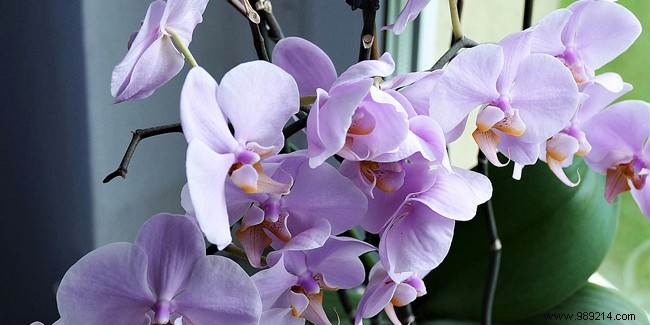
The orchid is a beautiful and very popular flower. This is why all occasions are good to offer one to those around you. However, it is a delicate and fragile plant. To be able to bloom again, the orchid requires special care, especially since it usually only flowers once a year. Our advice.
The orchid is a plant that needs sun and light. To put the odds on your side so that your flower can bloom again once its old flowers have faded, you must make sure that it receives enough light. For example, you can place your orchid near a bright window, taking care, however, that it is not too exposed to direct sunlight, especially if you live in a hot region and during spring and summer. Prefer a place where the sun enters only in the morning.
To tell if your orchid is getting enough light, inspect the color of its leaves. If they are dark green, it could be a sign that your plant is not getting enough light. On the contrary, if the leaves of your orchid are a lighter green, or with red spots, your plant is probably too exposed to light.
In order for your orchid to bloom again, remember to carefully control its watering. This plant needs water to grow and give new flowers. But the soil in which it is planted should not be soggy. Preferably bathe the pot in a basin of water for 10 minutes to irrigate it, every 2 weeks or every 10 days or so. This method of watering also allows the roots of the orchid not to stay too long in too wet soil. If you want your orchid to bloom again, do not let water stagnate at the bottom of its pot or cache-pot.
In general, the orchid appreciates warm and humid atmospheres which favor its flowering. So be careful to maintain a certain humidity in the room where it is placed, especially in winter when the heating is on.
The orchid, like all plants, develops better and has a better chance of flowering again if it is given fertilizer. This contribution must however be well dosed and not be too important. It is also necessary only if your orchid is making new roots or new leaves. Give it preferably a liquid organic fertilizer (which does not have to be a special orchid fertilizer) every 2 weeks or in case of new growth.
To promote the flowering of your orchid, it is also advisable to replace its soil every 2 years, or even every year. For repotting this delicate plant, use ready-made potting soil available in garden centers and specially designed for orchids.
Unlike many flowering plants, it is not always necessary to remove the stem that made the flowers once the flowers have faded, especially if it is the Dendrobium . On the other hand for Phalaenopsis , the most common type of orchid among the more than 25,000 existing varieties, it will be necessary to cut the faded flower stem by pruning the stem which has given flowers at the level of its second or third node, by cutting it at an angle. It can happen that flowers regrow quite well on this same stem, sometimes up to three times in a row, but in this case it does not dry up and develops a side terminal shoot.